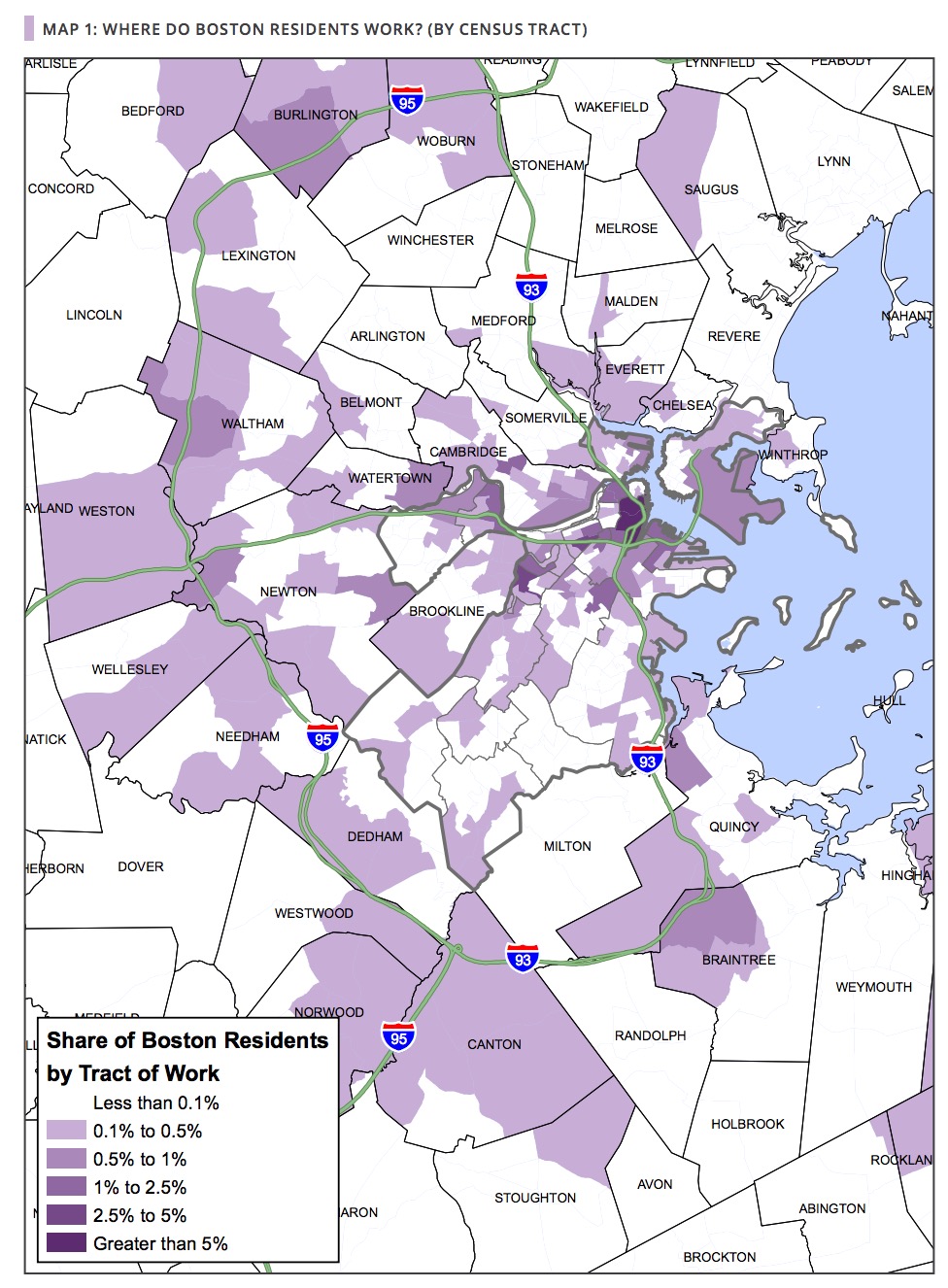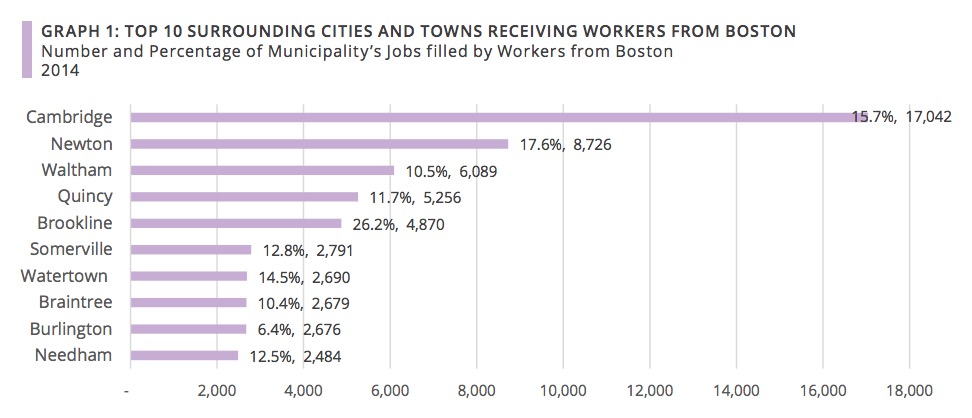BOSTON REDEVELOPMENT AUTHORITY
RESEARCH DIVISION
Introduction
Cities and towns are not closed economic systems, and commuting patterns reflect interactions within the regional economy. Workers who reside in one town may work in a neighboring town. Jobs in a given town may be filled by a combination of resident workers and commuters. This report examines residential and employment patterns in the greater Boston area and the resulting commuter flows.
Commuting Patterns
Boston and Surrounding Cities and Towns
Some cities host more jobs than resident workers and “import” labor. These cities become regional employment centers. Other towns house more resident workers than jobs in the town and “export” labor to neighboring towns. These towns have a more residential than commercial focus.
Table 1 shows the number of payroll jobs in each city and town compared to the number of payroll workers who live in the municipality. These cities and towns include Boston and the municipalities that are among either the top fifteen origins for commuting to Boston or the top fifteen destinations for commuting from Boston (or both). Ratios of jobs to resident workers above 1.0 denote municipalities that are more commercially oriented. Cities or towns with ratios of jobs to resident workers below 1.0 are more residentially oriented.
Residents of cities with large commercial sectors are more likely to find a job within their own city. Table 2 shows the percent of resident workers living in each city or town who hold a payroll job in their own municipality and in Boston. Boston, the region’s largest employment center, employs a significant percentage of the workers living in surrounding cities and towns. For example, more than 35 percent of the resident workers of Revere, Quincy, Chelsea, and Cambridge work in Boston. Close to half of resident workers living in Brookline work in Boston. Residents of cities that host many jobs may nevertheless commute to another city or town to find the most suitable job – for example, only 54 percent of Boston residents who hold payroll jobs work in Boston.
Even with a perfect match of skills and interests, Boston and many commercially oriented cities and towns would not have enough resident workers to fill all of the jobs in the city. Table 3 shows the percentage of jobs in a given municipality that are filled by residents of that city or town. A small minority of payroll jobs in most municipalities are filled by residents – 27 percent of payroll jobs in Boston are filled by residents of Boston. Boston residents also fill 26 percent of the payroll jobs in Brookline, 18 percent of the jobs in Newton, and 16 percent of the jobs in Cambridge. Only 4 percent of payroll jobs in Burlington are filled by residents of Burlington, while 6 percent of them are filled by Boston residents.
Commute Patterns in and out of Boston
Because of Boston’s large economy and population, commuter flows in and out of Boston have implications for regional transportation and housing planning. Map 1 shows where Boston residents work by census tract. The jobs held by Boston residents are concentrated especially in downtown Boston and Longwood, in Cambridge, and along transportation corridors such as Route 95.
The top ten towns where Boston residents work (other than Boston) are shown in Graph 1. In absolute numbers, Cambridge receives by far the largest numbers of workers from Boston. As previously shown in Table 3, these 17,042 workers from Boston fill 16 percent of the payroll jobs in Cambridge. Other municipalities receiving large numbers of workers from Boston are Newton, Waltham, Quincy, and Brookline.
Commuters come to Boston from all over the metropolitan area. Map 2 shows where people who work in Boston live by Census tract. The map shows concentrations of commuters in cities and towns with easy access to Boston through highways and public transportation. Almost 58 percent of people who work in Boston live within I-95 and approximately 84 percent live within I-495.
The top ten cities and towns for commuters into Boston are shown in Graph 2. Quincy sends the most residents to payroll jobs in Boston – 18,023 in 2014. Interestingly, Graph 2 shows that, at the same time that Boston is sending about 17,000 workers to Cambridge, Cambridge is sending almost 17,000 workers to jobs in Boston. Residents of Somerville, Newton and Brookline also make up a large number of commuters to Boston.
Download full version (PDF): Employment and Residence Patterns in Greater Boston
About the Boston Redevelopment Authority
http://www.bostonredevelopmentauthority.org/
In partnership with communities, the BRA plans Boston’s future while respecting its past. By guiding physical, social, and economic change in Boston’s neighborhoods, the BRA seeks to shape a more prosperous, resilient and vibrant city for all.
Tags: Boston, Boston Redevelopment Authority, BRA, commuting, MA, Massachusetts








 RSS Feed
RSS Feed